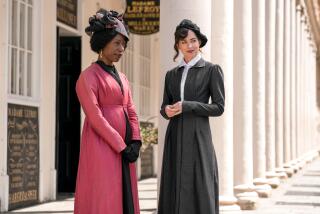ANNE OF GREEN GABLES: THREE VOLUMES IN...
- Share via
ANNE OF GREEN GABLES: THREE VOLUMES IN ONE by Lucy Maud Montgomery (Crown: $7.98; 634 pp.; age 12 up). When Mark Twain read “Anne of Green Gables” shortly after its 1908 publication, he sent a personal letter to the author, praising her for creating “the dearest and most lovable child in fiction since the immortal Alice.” At the same time however, the New York Times reviewer was less pleased, grumbling how “Anne is a bore . . . a mawkish, tiresome, impossible heroine.”
The heroine in question is the feisty Anne Shirley from the fictitious village Avonlea on Prince Edward Island, Canada’s smallest province. She’s a red-haired orphan mistakenly sent to an elderly sister and brother, Marilla and Matthew Cuthbert, who requested male help for their farm, Green Gables. Instead of a boy, however, the 11-year-old waif arrives only to win their hearts before they can return her to the orphanage. Anne embraces her new life with the exuberance and passion of a love-starved romantic, continually expressing her joy in nature. “Isn’t it splendid there are so many things to like in this world?” she says in one of her many long-winded accolades. Loquacious, yes. Impossible, perhaps, when you consider her temper and knack for mishaps. But boring, no way.
The first volume in this reissue introduces Anne as the daydreaming schoolgirl who falls in and out of mischief with hilarious charm. When Matthew dies she turns down a college scholarship to care for Marilla, to teach and to save Green Gables from being sold. The second volume, “Anne of Avonlea,” sees her through her teaching years and a flowery romance with Gilbert Blythe, formerly her childhood foe. The final one is “Anne’s House of Dreams,” describing her first year of marriage and new life at Four Winds Harbor where tragedy shakes her ideals but not her spirit. Every chapter is titled and ink drawings evoke the old-fashioned innocence from the turn of the century. In fact, archaic spellings and idioms are retained from the original editions to convey the flavor of the time. On describing the birth of Anne’s son we find that “. . . a certain weary stork flew over . . . (and) (u)nder his wing was tucked a sleepy, starry-eyed, little creature.”
The author’s life seems to parallel that of her heroine’s: Her mother died when she was 2 years old so she was sent to live with her grandparents on their farm. She taught school then delayed marriage until she was 36 to tend her aging grandmother. Montgomery started “Anne” as a brief serial for a Sunday school paper, but to her surprise the character ballooned and a novel evolved. After five publishers rejected the manuscript, the disheartened writer stashed it in a hatbox. Eventually, she sent it to L. C. Page & Co. of Boston, who launched it on the best-seller’s list. By 1914, “Anne” was in its 38th edition, with seven sequels in the works. It is thought by some to be the most enduring girls’ story from the early 20th-Century, even more popular than “Pollyanna” (1913) and “Rebecca of Sunnybrook Farm” (1903).
Now the concern: It’s doubtful this mega-volume, whose first sentence is 148 words long, can woo teens away from today’s pocket romances that are scrawny enough to be snuck-read during algebra class; 634 pages are intimidating. But if readers can venture a first step by removing the dust jacket, they’ll discover a handsome mahogany cover with gold lettering on its spine, rock heavy, with an aroma of sturdy paper. Then maybe they’ll be enticed to explore, thereby learning the great pleasure to be found when a character occupies your thoughts day after day.
More to Read
Sign up for our Book Club newsletter
Get the latest news, events and more from the Los Angeles Times Book Club, and help us get L.A. reading and talking.
You may occasionally receive promotional content from the Los Angeles Times.





